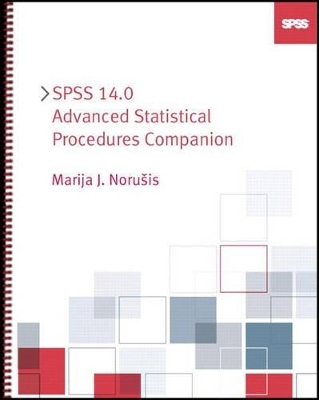
SPSS 14.0 Advanced Statistical Procedures Companion
Pearson
978-0-13-174700-5 (ISBN)
- Titel erscheint in neuer Auflage
- Artikel merken
For additional information, go to This site offers a detailed Table of Contents, features, examples included in the book, and a sample chapter for download.
SPSS 14.0 Advanced Statistical Procedures Companion: Chapters
1. Model Selection in Loglinear Analysis. Model formulation; parameters in saturated models; hypothesis testing; convergence; goodness-of-fit tests; hierarchical models; generating classes; model selection with backward elimination.
2. Logit Loglinear Analysis. Dichotomous logit model; loglinear representation; parameter estimates; goodness-of-fit statistics; measures of dispersion and association; polychotomous logit model; interpreting parameters; examining residuals; introducing covariates.
3. Multinomial Logistic Regression. Baseline logits; likelihood-ratio tests for models and individual effects; evaluating the model; calculating predicted probabilities; the classification table; goodness-of-fit tests; residuals; pseudo R-square measures; overdispersion; model selection; matched case-control studies.
4. Ordinal Regression. Modeling cumulative counts; parameter estimates; testing for parallel lines; model fit; observed and expected counts; measures of strength of association; classifying cases; link functions; fitting a heteroscedastic probit model; fitting location and scale parameters.
5. Probit Regression. Probit and logit response models; confidence intervals for effective dosages; comparing groups; comparing relative potencies; estimating the natural response rate; multiple stimuli.
6. Kaplan-Meier Survival Analysis. Calculating survival time; estimating the survival function, the conditional probability of survival, and the cumulative probability of survival; plotting survival functions; comparing survival functions; stratified comparisons.
7. Life Tables. Calculating survival probabilities; assumptions; observations lost to follow-up; plotting survival functions; comparing survival functions.
8. Cox Regression. The model; proportional hazards assumption; coding categorical variables; interpreting the regression coefficients; baseline hazard and cumulative survival rates; global tests of the model; checking the proportional hazards assumption; stratification; log-minus-log survival plot; identifying influential cases; examining residuals; partial (Schoenfeld) residuals; martingale residuals; variable-selection methods; time-dependent covariates; specifying a time-dependent covariate; calculating segmented time-dependent covariates; testing the proportional hazards assumption with a time-dependent covariate; fitting a conditional logistic regression model.
9. Variance Components. Factors, effects, and models; model for one-way classification; estimation methods; negative variance estimates; nested design model for two-way classification; univariate repeated measures analysis; using a Mixed Models Approach; distribution assumptions; estimation methods.
10. Linear Mixed Models. Background; Unconditional random-effects models; hierarchical models; random-coefficient model; model with school-level and individual-level covariates; three-level hierarchical model; repeated measurements; selecting a residual covariance structure.
11. Nonlinear Regression. The nonlinear model; transforming nonlinear models; intrinsically nonlinear models; fitting a logistic population growth model; finding starting values; approximate confidence intervals for the parameters;bootstrapped estimates; starting values from previous analysis; linear approximation; computational issues; common models for nonlinear regression; specifying a segmented model.
12. Two-Stage Least-Squares Regression. Demand-price-income economic model; estimation with ordinary least squares; feedback and correlated errors; estimation with two-stage least squares.
13. Weighted Least-Squares Regression. Diagnosing the problem; estimating weights; examining the log-likelihood function; the WLS solution; estimating weights from replicates; diagnostics from the linear regression procedure.
14. Multidimensional Scaling. Data, models, and multidimensional scaling analysis; nature of data analyzed in MDS; measurement level of data; shape of data; conditionality of data; missing data; multivariate data; classical MDS; Euclidean model; details of CMDS; Replicated MDS; Weighted MDS; geometry of the weighted Euclidean model; algebra of the weighted Euclidean model; matrix algebra of the weighted Euclidean model; Weirdness index; flattened weights.
| Erscheint lt. Verlag | 30.3.2006 |
|---|---|
| Zusatzinfo | Illustrations |
| Sprache | englisch |
| Maße | 189 x 229 mm |
| Gewicht | 592 g |
| Themenwelt | Mathematik / Informatik ► Mathematik ► Computerprogramme / Computeralgebra |
| ISBN-10 | 0-13-174700-2 / 0131747002 |
| ISBN-13 | 978-0-13-174700-5 / 9780131747005 |
| Zustand | Neuware |
| Haben Sie eine Frage zum Produkt? |